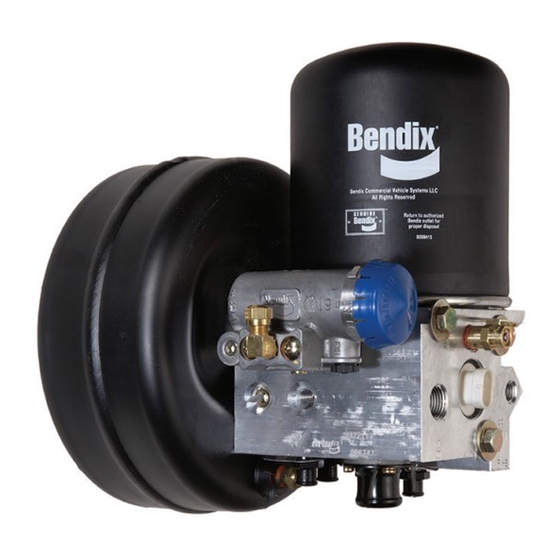BENDIX SD-08-2418 Manuel - Sayfa 8
Nem Alıcı BENDIX SD-08-2418 için çevrimiçi göz atın veya pdf Manuel indirin. BENDIX SD-08-2418 17 sayfaları.

OPERATION & LEAKAGE TESTS (REFER TO
THE TROUBLESHOOTING CHART IN THIS
MANUAL)
For additional information see video BW2327 – available
through the Document Library on bendix.com.
1. Check all lines and fittings leading to and from the
air dryer & reservoir system for leakage and integrity.
Repair any leaks found.
2. Build up system pressure to governor cut-out and note
that the Bendix
AD-IS
®
escape of air. Watch the system pressure and note the
pressure fall-off for a ten minute period. If pressure
drop exceeds – a) for a single vehicle: 1 psi/minute from
either service reservoir; or b) for tractor trailer: 3 psi/
minute from either service reservoir – inspect the vehicle
air systems for leak sources and repair them. Refer to
Symptoms 1 and 4 in the Troubleshooting Chart.
3. Be sure to wear safety glasses in case of a
purge blast. Check for excessive leakage around
the purge valve with the compressor in the charge mode
(compressing air). Apply a soap solution to the purge
valve exhaust port and observe that leakage does not
exceed a 1" bubble in one second. If any leakage
exceeds the maximum specified, refer to Symptom 4
in the Troubleshooting Chart.
4. Build up system pressure to governor cut-out and note
that the AD-IS air dryer purges with an audible burst of
air, followed immediately by air flowing out of the purge
valve. See Table 2 for the time required for the entire
contents of the purge reservoir of a Bendix AD-IS air
dryer & reservoir system to flow through the desiccant
drying bed. Fan the service brakes to reduce system
air pressure to governor cut-in. Note that the system
once again builds to full pressure and is followed by a
purge. If the system does not follow this pattern, refer
to Symptoms 5 and 6 in the Troubleshooting Chart.
5. Check the operation of the end cover heater and
thermostat assembly during cold weather operation as
follows:
A. Electric Power to the Dryer (Refer to Figure 4.)
With the ignition or engine kill switch in the RUN
position, check for voltage to the heater and
thermostat assembly using a voltmeter or test light.
Unplug the electrical connector at the air dryer &
reservoir system and place the test leads on each
of the connections of the female connector on the
vehicle power lead. If there is no voltage, look for a
blown fuse, broken wires, or corrosion in the vehicle
wiring harness. Check to see if a good ground path
exists.
8
air dryer purges with an audible
®
Heater &
Thermostat
Connector
Figure 4 - Heater and Thermostat Connector
B. Thermostat and Heater Operation
Note: These tests are not possible except in cold
weather operation.
Turn off the ignition switch and cool the thermostat
and heater assembly to below 40°F. Using an
ohmmeter, check the resistance between the
electrical pins in the air dryer & reservoir system
connector half. The resistance should be 1.5 to 3.0
ohms for the 12 volt heater assembly, and 6.0 to 9.0
ohms for the 24 volt heater assembly.
Warm the thermostat and heater assembly to
approximately 90°F and check the resistance
again. The resistance should exceed 1000 ohms.
If the resistance values obtained are within the
stated limits, the thermostat and heater assembly is
operating properly. If the resistance values obtained
are outside the stated limits, replace the heater and
thermostat assembly.
6. Pressure Protection Valves. Observe the pressure
gauges of the vehicle as system pressure builds from
zero. The primary or secondary gauge should rise until
it reaches approximately 106 psi (±6 psi), then level
off (or a momentary slight fall) as the next pressure
protection valve opens – supplying its reservoir. When
that pressure gauge passes through approximately 106
psi (±6 psi) there should be an associated leveling off (or
momentary slight fall) of pressure as the third and fourth
pressure protection valves open. Then the primary and
secondary gauges should increase together until they
reach their full pressure of approximately 130 psi (±5
psi).
